
Knocking out a tooth is quite a stressful situation, but knowing what to do and acting quickly may allow you to have it successfully saved and reimplanted in its socket. The field of dentistry is committed to preventing tooth loss, and dentists have ways that allow lost teeth to integrate with the soft tissue and bone structure if they can address the issue quickly enough. Here’s a brief guide to what you can do to save a tooth that has been knocked out.
First Things First: Secure the Lost Tooth
A tooth’s chances of being reimplanted begin to drop about thirty minutes after it is knocked out, so it’s important to act quickly if one becomes dislodged. Begin by locating the lost tooth and handling it only by the crown, as touching the exposed root can damage the delicate tissues there. If it is dirty, clean it by swishing it about in lukewarm water, as hot or cold water or cleaning agents can damage the tooth.
Second Order of Business: Prepare the Tooth for Transport
Once the tooth is secured, it’s important to get it to the emergency dentist’s office as quickly as possible. If you can, gently place the tooth back in its socket or the lip or cheek. Otherwise, put it in a container with some milk or saliva to keep it from drying out. Call the dentist’s office to explain the situation and let them know you are coming. You’ll be in good hands once you reach the office.
What If the Emergency Dentist’s Office Isn’t Open?
Dental emergencies can still happen after dental offices typically close for the day. If you find yourself with a dislodged tooth when you emergency dentist’s office isn’t open, head for the emergency room. While the staff there cannot reimplant the tooth, they can prescribe pain relievers and antibiotics if necessary and provide you with a treatment that can keep your tooth in savable condition for up to twenty-four hours. You can also buy similar kits that can keep a dislodged tooth reimplantable for a whole day at pharmacies, so you may want to stock up.
Many a person has suffered a knocked-out tooth only for a compassionate dentist to fix it back in place so that it’s as good as new. Knowing what to do when you dislodge a tooth can save you a lot of frustration as well as the expense of replacing it.
About the Author
Dr. Andrew Betaharon earned his dental degree at the University of Maryland School of Dentistry and completed his general practice residency at the Veterans Affairs Hospital in Long Beach, CA. He is proud to be a member of the American Dental Association and the American Academy of Cosmetic Dentistry, and his office in La Plata, MD, offers general, restorative, cosmetic, and emergency dental services. If you have dislodged a tooth, dial his office at (240) 349-2439. For non-emergency inquiries, please contact his office online.
 La
Plata
La
Plata